Civil engineering
-
1. Double-Deck Controlled Blast TechnologyThis innovative blasting technology is used for tunnel construction. The sectors that had to be blasted in two separate attempts to control vibration can now be blasted at once, using advanced electronic detonators and double-deck explosive mounting methods. This method minimizes vibration while shortening the construction time significantly.
-
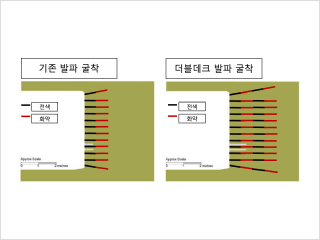 Blasting technology preventing detonation cords being cut offUsing electronic detonators (exploding devices that are operated electrically), the time of explosion can be controlled precisely to build a tunnel. This makes it possible to blast in two different levels, upper and lower decks (thus double-deck blasting), making tunnel construction even more safe and efficient.
Blasting technology preventing detonation cords being cut offUsing electronic detonators (exploding devices that are operated electrically), the time of explosion can be controlled precisely to build a tunnel. This makes it possible to blast in two different levels, upper and lower decks (thus double-deck blasting), making tunnel construction even more safe and efficient. -
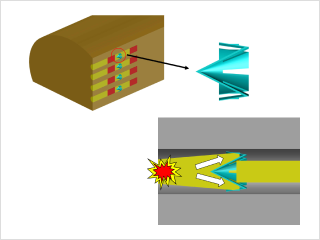 Blasting deck charge technologyThis technology uses tamping materials (the material that is used to block the detonation hole) to detonate the explosives for a blasting job in a more effective way. The tamping material is designed to hold onto the wall of the detonation hole even stronger when the first blast happens. This blocks the hole even tighter and increases friction. As a result, the second blast is executed in a more effective manner, preventing misfires where the explosives do not detonate.
Blasting deck charge technologyThis technology uses tamping materials (the material that is used to block the detonation hole) to detonate the explosives for a blasting job in a more effective way. The tamping material is designed to hold onto the wall of the detonation hole even stronger when the first blast happens. This blocks the hole even tighter and increases friction. As a result, the second blast is executed in a more effective manner, preventing misfires where the explosives do not detonate.- Reference project: Anseong-Guri Express Way Sector 11
- Intellectual property rights: Registered patent 10-1972124
-
-
2. TBM (Tunnel Boring Machine) Tunnel Segment Optimization TechnologyThe Drilling and Blasting tunneling method (NATM etc.) is sometimes not an option in an urban area or an environment with softer ground. In such cases, the TBM method that uses a tunnel boring machine is widely used. This method emits lower vibration and noise and safer, which makes the technology even more popular lately. Especially, continued R&D efforts on the assembly of tunnel walls (segment process), which accounts for about 30% of the total construction cost of a TBM project, made it possible to enhance the quality of construction work even further.
-
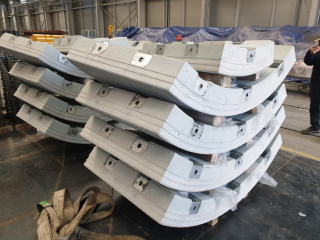 Steel fabric segment lining technologyThis technology replaces conventional rebars with steel fabric to dramatically enhance tensile strength and resistance against cracking. This simplifies the manufacturing process and saves 10 to 20% of the cost compared to rebars. The 3-dimensional strengthening effect of steel fabric also enhances the durability and ductility of the corners of the segment significantly, as well.
Steel fabric segment lining technologyThis technology replaces conventional rebars with steel fabric to dramatically enhance tensile strength and resistance against cracking. This simplifies the manufacturing process and saves 10 to 20% of the cost compared to rebars. The 3-dimensional strengthening effect of steel fabric also enhances the durability and ductility of the corners of the segment significantly, as well. -
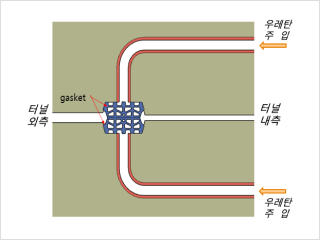 Segment lining tunnel waterproofing technologyIn this technology, a special rubber gasket is installed between segments of the wall to inject sealant fluids into the gap. This allows tight waterproofing from the beginning and, even if there is water leakage during construction, additional injection of the sealant can fix the problem immediately.
Segment lining tunnel waterproofing technologyIn this technology, a special rubber gasket is installed between segments of the wall to inject sealant fluids into the gap. This allows tight waterproofing from the beginning and, even if there is water leakage during construction, additional injection of the sealant can fix the problem immediately.- Registered patent: 10-2022-0003749
-
-
3. ITPC Tech. PackageThe ITPC technology (Integrated Tunnel & Pre-Cast) allows applying pre-cast methods to each phase of a tunnel project which is being built using conventional methods and making them into packages. We expect this technology will reduce the construction cost and construction time when applied to the deep-depth underpass projects of which the market volume will expand to about 30 trillion won in the future.
-
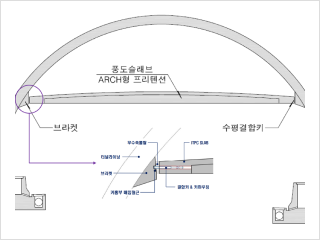 ITPC-Slab SystemIt is an improvement in terms of how the floor slabs and supporting brackets inside a tunnel are connected. While the conventional method was to just stack them, this method joins them laterally, reducing the size of the bracket and making wall construction easier.
ITPC-Slab SystemIt is an improvement in terms of how the floor slabs and supporting brackets inside a tunnel are connected. While the conventional method was to just stack them, this method joins them laterally, reducing the size of the bracket and making wall construction easier.- Reference project: Namhae-Yeosu Undersea Tunnel
- Intellectual property right: Registered Patent 10-2650618
-
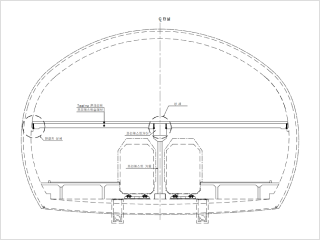 ITPC-Station SystemWe upgraded the floor construction process of a subway station from site casting to pre-cast structure installation, significantly reducing construction time. We applied a new method in which the brackets and the central structures were joined laterally to reduce the sizes of brackets and make wall construction easier. It is possible to level the floor by casting concrete topping.
ITPC-Station SystemWe upgraded the floor construction process of a subway station from site casting to pre-cast structure installation, significantly reducing construction time. We applied a new method in which the brackets and the central structures were joined laterally to reduce the sizes of brackets and make wall construction easier. It is possible to level the floor by casting concrete topping.- Intellectual property rights: Patent application 10-2024-0036696
-







